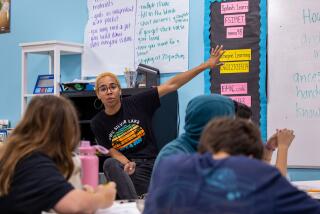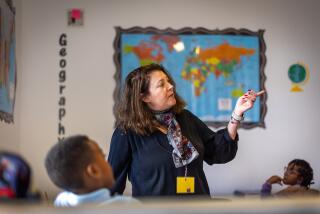Cursive Writing : Learning to Make the Connection
- Share via
The letter “t” is hydrophobic. The “j” is a slothful klutz. And the upper-case “e” may well be the “most important letter ever invented.”
So contends Edie Gladden, a third-grade instructor at Miller Elementary School in Tierrasanta whose unusual method for teaching children to write cursive is earning high marks from educators, parents and students.
“The whole key is making it fun, meeting the kids’ needs,” said Gladden, 57, who has been teaching handwriting at the school for about 14 years. “You set a bunch of high expectations for the kids, and you help them get there. It should be above the level of boring, grinding homework.”
Though she said she knows of only a few teachers who use similar programs, Gladden maintained that little about her method is esoteric.
Families of Letters
“It’s not that hard,” she said. “I take letters that are similar, and I tell the children that they are families. Then, I try to show them how they are all similar.”
For instance, she said, the lower-case “i” family is composed of the letters “u,” “w,” “j” and “t.”
“The ‘u’ is twin letter ‘i’s’,” said Gladden. “The ‘w’ is a ‘u’ with a serving tray. The ‘t’ is the ‘i’ with an umbrella that protects it from the rain--it doesn’t like rain. And the ‘j’ is a lazy ‘i’ that falls down.”
Occasionally, when teaching the 85 students who cram into Room 4C for their lessons, Gladden--assisted by two teachers and an aide--also throws in tall tales about the letters to accompany her descriptions.
“And what is really different is that all of our writing is done on regular paper,” she said. “We don’t use those ditto sheets.”
In most elementary cursive-writing programs, children begin by tracing over letters already printed on carbon paper, or “ditto sheets.”
Gladden’s assistants acknowledge that those unfamiliar with the program sometimes find it strange and even silly--especially the part about the “families.”
“The approach sounds a bit hokey, but this is really children’s talk,” said Pitt Warner, a teacher who has worked with Gladden for about two years. “The children associate with it, and it helps.”
Students Like It, Too
In fact, the students said, the method works so well that many of them would rather write than play.
“It’s fun,” said Michael Timoteo, 7, whose neat cursive penmanship was rewarded with a new pencil Thursday. “I have a good time in handwriting. I like it better than recess sometimes. I don’t know why, but it’s just fun.”
Fun or not, the assistants said, when showing third-graders how to write cursive letters, teachers need all the help they can get.
“The transition from print to cursive is difficult for the kids,” Warner explained. “They have a hard time making the letters connect. Their undeveloped hand-eye coordination has a lot to with their problems.”
“Their muscles aren’t always developed, either,” added teacher James Hilley, who has taught alongside Gladden for about three years. “It’s hard for kids to pick up on. That’s why they start in the third grade. And even then, some kids can’t do it.”
Lots of ‘Back-Patting’
They said Gladden’s method shifted emphasis away from the difficulty of cursive writing and onto the importance of the childrens’ effort to learn.
“We don’t have to say how hard it is,” Warner said. “We know it’s hard for them, but we want them to try. No one does poorly in this class. There’s a lot of back-patting here.”
Warner said even students who have a hard time mastering the new form of writing are lauded.
“We tell them, ‘Oh, that’s some of the best writing I’ve ever seen,’ and stuff like that,” he said. “It may seem like a bunch of malarkey, but if you are sincere, they’ll believe you.”
Miller administrators said they too are believers, won over by the success rate of the method and its impact on the dying art of penmanship.
“This program has been very important in showing kids the need for penmanship,” said Rosary Nepi, the principal of Miller. “I think what she’s doing is good for the kids and the curriculum. She happens to be one of the top teachers in the city in language arts.”
But Gladden is quick to point out that she was not alone in developing the program. She picked up much of it 15 years ago at a teachers’ seminar at San Diego State University.
Calls System ‘Logical’
“It seemed funny, but it was the most logical way to teach it,” she said. “Now, I can’t see myself teaching any other way.”
Parents who have had children under Gladden’s guidance said they don’t want it any other way.
“She’s taught four of my kids to write cursive,” said Nikki Smith, who started working as Gladden’s aide five years ago. “My oldest was too old and couldn’t be taught by her, but I made him come back to an adult session she used to teach. I wouldn’t be with her if she was not a good teacher.”
Still, Gladden said, even she is not perfect. She said there are 12 students who didn’t make it through this course, which is now in the second of nine weeks.
“They’re going over their print again,” she said. “They’ll be allowed to try again in October.”
Gladden’s assistants said most of the 12 who washed out had either missed some homework assignments or had behaved poorly.
“(Gladden) keeps these kids under control,” Hilley said. “When teachers come in here, they are amazed at the low noise factor. High on discipline, that’s what we are also known for.”
But the students prefer to look at the other side of the program.
“This is cool, because you get to learn how to write your name in cursive,” chimed in Mark Jones, 8. “It’s really fun. We just learned how to spell Edie--and that’s pretty funny.”
More to Read
Sign up for our Book Club newsletter
Get the latest news, events and more from the Los Angeles Times Book Club, and help us get L.A. reading and talking.
You may occasionally receive promotional content from the Los Angeles Times.








